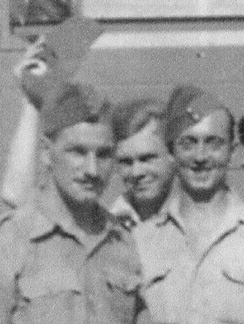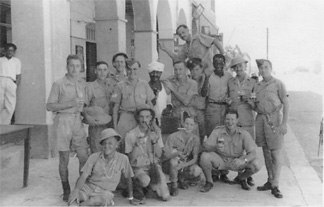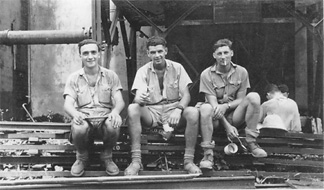 |
 |
|||||||
|
LAC Thomas Dent Henderson 628120 RAF 1921—1988 Born in August 1921, from his service number Tom Henderson joined the RAF as a civilian sometime in December 1938 or early January 1939, at the age of 17 or so—the peacetime minimum age for direct entry as an airman being 17 years and 3 months. By Christmas 1939, he had turned 18, qualified as an Armourer, and had been posted overseas to join 211 Squadron in the Middle East. Henderson was one of several County Durham men to serve with the Greyhounds. He was to be well known among the groundcrew: serving in the Western Desert, Greece, Palestine and the Sudan from 1940 to 1941; then on to Sumatra and Java in January 1942 until the Squadron dispersed there in March. Tom was one of the lucky ones at the last in Java, to be among the Tung Song evacuees arriving at Fremantle in Western Australia in March 1942. The survivors were soon moved back to India, where he was among the group photographed some time before their final scattering. Although the Squadron did re-form in India, with Bristol Beaufighters from August 1943, by then all the old hands had moved on.
Enlarged from the large Derha Dun group photograph, prints of which were held by the late Jim Fyratt (another Armourer of the Squadron) and by Ron Dudman.(Fitter II/Engine). In the course of correspondence several years ago about Fred Joerin’s time with the Squadron, Brian Cull was kind enough to give me not only Joerin’s Flying Log Book but also a deeply interesting letter from Tom Henderson dating from the early 1980s (all now returned). Since then, my UK friend Ian Carter has kindly dug through his own 211 Squadron collection to send me cracking copies of some of Tom’s photographs. Here then, is the vivid narrative of Leading Aircraftman Tom Henderson, an Armourer of No 211 Squadron RAF from desert landing ground to jungle airstrip. I’ve chosen to omit the personal salutations and another aside, and the usual lavish capitalisation. Apart from a few silent spelling corrections, omissions and comments of mine are shown in the usual way, [thus]. [Narrative of a Greyhound] On a personal note, this service covered the Western Desert (Wavell's campaign), Greece, Crete (Heraklion), Iraq (Raschid Ali's Rebellion), [the Free French action in Syria], Sudan, Sumatra, Java, Australia and India. I still regarded myself as a de facto 211 Sqn member until leaving India in 1942 to commence a long overdue Pilot's course in Rhodesia (successful I'm happy to say!) and finished the war on Lancasters operating over Europe. Up until the latter half of 1942, the RAF saw fit to employ me as an NCO Armourer and Ground Gunner. I was 20 years old at the time of the Far Eastern fiasco, therefore any information I can give you [Brian Cull] is limited to the limited capacity I was experiencing at this period. Naturally I'm biassed, being a true "Greyhound" of somewhat jealous disposition. If any part of this communication will help do feel free to use it [see Bloody Shambles Ch 1 p72]. The only stipulation I make is please return the photographs, such as they are. At least they show what some of us looked like and where we were. Nothing exciting I'm afraid, due to lack of film. [...] [The photographs which follow may or may not be those which Tom referred to. He did later make some available to Ian Carter, who kindly gave me copies which I have used here to illustrate Tom’s narrative.]
Taken at Port Sudan. Hot and thirsty. Drinks in evidence plus festive garlands. Front row, sitting: Bob Livesey, unknown, Chico Broadbent, F/Lt Homes-Lee. Some of the other faces seem to be familiar from the indoor beano shot, also taken at Port Sudan, in Jim Fryatt’s collection.] Before I start being technical, do pass on my respects and salutations to AVM Bateson. Having no more military ambition I now feel free to state how much I enjoyed his command and what a jolly good type he was. [Bateson died in March 1986, which at least places Tom’s letter to a date before that]. To the late Sqn Leader Ken Dundas, a special salute. In earlier and happier days this officer gave me hours and hours of his time preparing me as a more plausible candidate for the highly desirable state of Sergeant Pilot. His death on the 10th of February [1942] was a hard blow to we longer serving members who held him in great esteem as an officer and a truly good man. Fortunately, for part of the period in question I kept a few hurried notes (Not a Diary! Who am I to disobey KRs and ACIs) which at least will keep things in chronological order.
Possibly Port Sudan sea-front, a Sergeant (front, kneeling) with a cheerful party of airmen.] Comments on Ops Resumé 211 Sqn Feb 1942 Here—for fun—is the "official" squadron song Early in the morning when the sun begins to show, Two Eleven's panicking, panicking, panicking, [This is a rather different version of the 211 Song than seen elsewhere. It's worth noting that the reference to panic is wry rather than coldly proscriptive, bearing in mind that, for example, the issue steel helmet was called (among other things) a panic hat or a panic bowler.] The reference to a salmon sandwich harks to the Desert campaign where we dined on tinned fish (type unknown) and raw Egyptian onions for six months. This brought on a rare tropical ailment that could only be cured by Stella beer. [Greek beer!] [“Mush” Hale (534599 Cpl Hale G, Armourer) gazes out over the desert floor of Wadi Gazouza towards the Red Sea Hills of The Sudan.] And so on to business. Extracts from personal records. [In fact the 72 OTU Movement Order dated 19 December directed that the main party was to entrain at 1800hrs on 20 December. No other Orders are present in the 72 OTU Operations Record Book. The Roll attached to the 19 December Order names 292 airmen, many of them old hands from the Desert and Greece. Included among the Armourers is one “628120 LAC Henderson TW”, plainly a typing error for Thomas Dent Henderson 628120.] Lots of panic at Helwan, promised the world but ended up with very second hand Blenheims. Much work getting them operationally ready. Wild speculation as to our next operational destination, Singapore and Far East odds-on favourites. Extra aircrew and groundcrew joined 211 Squadron here (Helwan) to replace large number of 5 year tour expired chaps returning to the UK. [January 16th] [The Air Party was staged into four Flights of six, departing over four days from 25 January, perhaps as much in response to the worsening situation in Malaya. Moves to set up the Group HQ on Sumatra were in train by 17 January]. [February 13th] At this stage rifles and a few machine guns (Lewis's) issued and entrained for Palembang [some 200 miles to the North]. Rumour has it that we have lost most of our aircraft and Japanese advance units are somewhere between us and Palembang. Before reaching Palembang train stopped, all off, and route march through swamp and jungle to a deserted rubber plantation. Slept here then paraded at first light. Machine gun and rifle party to stay behind, remainder to return to Oosthaven. Our party, for reasons unknown or invented, now called Major Grahams Rearguard Party. Morale very high, Medical Officer Doc Dawson still with us, he has a fund of delightfully smutty stories. Our Armament Officer (a W/O), first name Ginger, wish I could remember his surname also enthusiastically involved. [possibly W/O DM Fogg, ex Wadi Gazouza and a very old hand on 211 Squadron] [February 16th] Spent the remaining 48 hours blowing up ammo dumps, huts, etc. Last train passed through towards coast and received official permission to sabotage railway and to make as best we could for nearest port [ie return Oosthaven]. Armament Officer "acquired" a large American Pontiac and bristling with small arms drove off in style. A lot of air activity at this time, mostly Japanese, although we did see a Catalina flying boat. February 17th 1942 [Silver Larch had succeeded in reaching Oosthaven from Singapore, where she had arrived in late January carrying a very wide assortment of ordinance. The story is recounted in Campbell & Lovell’s So Long Singapore. Hugh Campbell would have been fascinated to hear of a 211 aboard her.] Rode on an ammunition train (mostly AA) to Batavia, highly uncomfortable but plenty of real food en route. Plenty of air activity. February 19th [Possible confusion here: the Japanese landed on Java on 1 March. The Dutch surrender order was made at 0900hrs on 8 March, wef from 1430hrs that day. The intent and extent of effect was subject of some dispute, post-war, but the effect was the same. Tjilatjap fell on 7 March, and for some period thereafter various ingenious endeavours to escape were made, some successful, some disastrous.]
A splendid shot. Good cheer in adversity. No names, unfortunately.] [March 2nd] Shipped aboard a funny looking vessel (coastal boat) name of Tung Song. From somewhere an RAF ensign has appeared and at last we have a decent MG, a Vickers K no less. We have acquired a few odd bods from other units and the latest gen is destination Australia. [The story has been also been told by others, more than once. In fact Tung Song was serving the RAF. Requisitioned under charter from 1939 as No 205 (Flying Boat) Squadron's sea-going tender, she ranged as far as Rangoon, the Nicobars, Singapore, and Oosthaven in support of the Squadron. The necessary Admiralty charts and Pilot volumes were not necessarily left lying about in plain view.].
Tom, listed among the evacuated airmen Armourers of 211 Squadron, safely accounted for at 5 Embarkation Depot Fremantle, along with Jim Fryatt, This time, he’s PD Henderson 628120. Such is the fabric of history. We were told later that we had gaily sailed through a minefield just off Fremantle! Flat bottoms are not to be laughed at! Summary Epilogue By coincidence, one Sergeant Thomas Dempsey Henderson 808269, also of County Durham, had been appointed to a commission from May 1942 as an Air Gunner and Wireless Operator. Pilot Officer TD Henderson 122975 was made Flying Officer on probation wef November 1942, and promoted Flight Lieutenant in May 1944: This TD Henderson remained in the RAF until at least October 1945. In June 1950. the Korean War broke out after a period of tension and cross-border incursions. In July 1950, ex-211 Squadron Corporal Thomas Dent Henderson 628120 was at last appointed to an RAF commission, as a Navigator II Pilot Officer with effect from 25 May—and with the same service number. His Short Service Commission was for a period of five years on the active list and four on reserve. In May 1952, Tom Henderson was promoted to Flying Officer in the Aircraft Control Branch, where he continued on the active list in the RAF Reserve of Officers until at least April 1957. After 20 years RAF service in war and peace, Flying Officer Thomas Dent Henderson 628120 finally relinquished his commission in May 1959, retaining his rank. In 1969, Tom Henderson met his match in Olga, with whom he enjoyed 18 years of happily married life. In late 1983, James Dunnet’s Flypast article on his old Squadron’s trials in Greece caught Tom’s eye. Soon he was writing to the magazine (his letter appearing in the January 1984 issue) and to James, his letters making a significant contribution to the final chapters of James’ ms of Blenheim Over the Balkans. Soon after that he was in touch with Ian Carter who, then as now, lived only a few miles away. About that time he was also writing to Brian Cull about the Squadron’s difficult days in the East Indies (as recorded here), and thus also made a contribution to Shores, Cull and Izawa’s Bloody Shambles Vol II. However, Tom passed away on 12 April 1988, long before its publication in 1993. He would have been very interested to hear of Hugh Campbell and Ron Lovell’s efforts from 1994 over the Tung Song story, So Long Singapore (published in 2000) and to see Blenheim Over the Balkans published (in 2001)—but that was not to be. Tom Henderson was survived by his wife Olga, who later married Ron Miller, an ex-Wellington man, whom she met through a cousin of Tom’s. Ron himself passed away on 29 June 2012. Although coping with arthritis in both hands, Olga writes the most kindly and wonderful letter, with fond memories of her “two wonderful husbands”. My sincere thanks go to her and, for that matter, to Ian Carter (whose long-standing friendship with Tom was one of the influences that led him to take such a big part in matters Blenheim and 211 Squadron).
Sources I Carter personal correspondence; photographs from TD Henderson RAAF 5 Embarkation Depot Fremantle NAA Series A10605 435/1 (5 ED Personnel Occurrence Reports 30/1942, 31/1942 etc) Air Ministry Index to Airmen and Airwomen UK National Archives TNA AIR 78/74 Campbell and Lovell So Long Singapore (Campbell 2000)
www.211squadron.org © D Clark & others 1998—2025 |
|||||||




